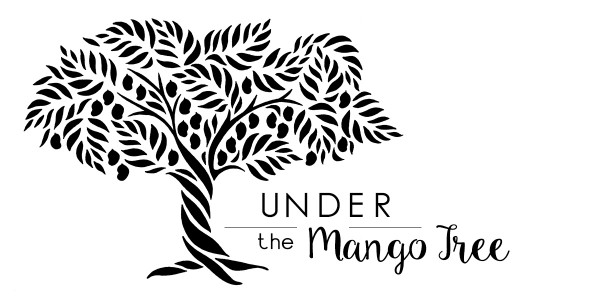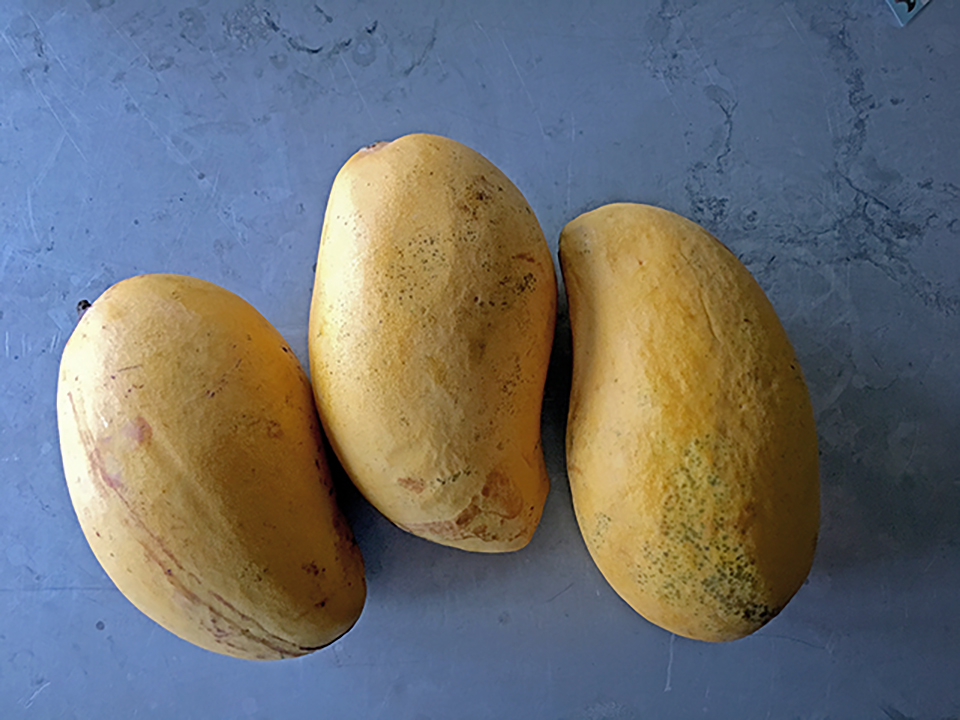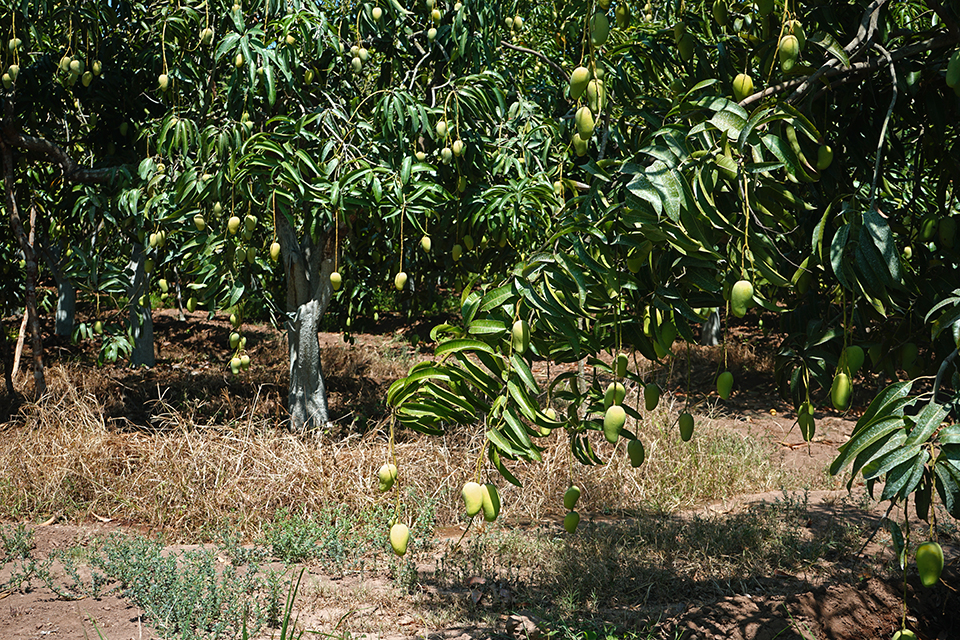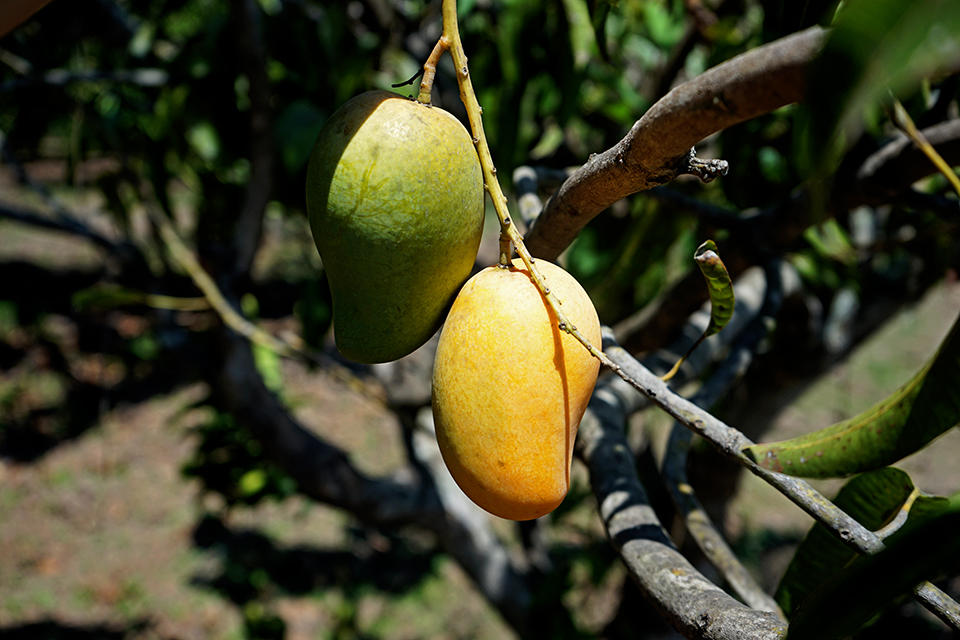Uncovering the facts about Ataulfo mango Latex staining & sap injury
This article was originally posted on Under the Mango Tree in February of 2017 and has been updated here.
Over the years, I really thought I understood the major problems affecting the “king of fruits,” specifically the varietals and those from the countries I worked with. Since I have traveled to orchards on multiple continents to examine the fruit and its “afflictions du jour,” I thought I had the facts straight on mango quality. Alas, since I met the Crespo family, I have come to discover that I had barely scratched the surface when it came to mango quality issues.
Like most everyone in the industry, I had to sift through a lot of misinformation about the quality of mangoes, but I tend to ask a lot of questions. And because I am me, I share the information I find. Under The Mango Tree’s goal has always been to get more accurate mango information to buyers, industry folks, and consumers. As we all struggle to compete in the complex agriculture world, this blog has been my attempt at being part of the solution. Talking about commodity imperfections is an important part of that process and an important part of commodity education.
Today I want to talk and share about the dark marks we see on many of the Ataulfo mangoes from time to time and most often from the ones that hail from the southern regions: Chiapas and Oaxaca. The good news in this particular affliction/imperfection is, that the mangoes ripen through the aesthetic imperfections, that tend to be more predominant when at the greener stage (when most of you receive the product), rather nicely and turn golden yellow without many blemishes (when the consumers see it). Harvesting and packhouse behaviors make a difference and so does talking about it.
Context: Mexican Growing Region
Climate patterns are changing so rapidly worldwide that there’s no commodity that isn’t seriously affected. Obtaining perfect fruit in large and consistent volumes is an impossible feat. We must begin to approach the supply chain more holistically in order for true sustainability to occur. A sustainable supply chain isn’t just about water, waste, and energy; it’s also about understanding that it’s a part of a bigger system. A great portion of that system in mangoes is composed of the farming regions and farmers of Mexico, Ecuador, and Peru. Each has their own complexities (…like that Leonardo DiCaprio movie: complexities, within complexities, within complexities).
The United States imports approximately 98% of all its mangoes. Most organic mangoes come from three countries: Mexico, Ecuador, and Peru. The Mexican mango season is by far the most complex, made up of over 7 geographically different production zones that move through 9 calendar months of the year. The regions, which mostly link up Mexico’s Pacific coast, stretch out more than 1800 miles, starting in the southern region of Chiapas in January and ending in northern Sinaloa in September. Each region has many different micro-zones and several different microclimates, all with various growing nuances and incredibly rugged terrains. Comparatively speaking, Peru and Ecuador’s mango seasons last approximately 3 months and stretch out no more than 200 miles, with only a few geographically different production zones in each.
Weather is increasingly complex and has the ability to relay detailed insight into the quality of mangoes. Cold off-season weather is crucial for a mango tree and a mango’s life cycle, yet we are seeing less and less of it annually. Rains are probably the most important aspect of weather for mangoes, and they are growing more unpredictable year after year. The rain in the off-season, the irrigation, the rain before or while blooming (or lack thereof) tends to dictate a majority of each region’s success. Rain after fruit formation and fruit maturity can wreak havoc on a crop. As weather patterns become more fickle, the fruit quality is more difficult to gauge. Farmers are seeing unique problems and more importantly a culmination of “a perfect storm” of problems that make the system even more complex and more difficult to estimate and foresee. It’s difficult to share information while it’s constantly evolving, let alone ensure it gets all the way back to the buyers. If we are talking about the entire mango industry, most buyers have several “middle man” hands in the mix before they even touch them.
There isn’t a cookie-cutter approach to understanding mango problems. They are constantly evolving and they are often uniquely layered. The best we can do is to try and understand these complexities one by one and share as much information as possible, moving through problems rather than pretending they do not exist. The more transparency there is in the process, the better off the entire supply chain system is, and the more holistic and sustainable it is.
Latex Staining/Sap Injury
This time of year I often field a lot of questions about latex staining (aka sap injury) in Ataulfo mangoes. Although I have to admit, a good portion of our customers are well aware of the issue and we move through it together, educating consumers as we simultaneously try and eliminate as much of it as we can.
Latex staining is a more serious issue in the southern regions than the north, and I still have not pinpointed why. It is most prevalent during the onset weeks of harvest in commercial production.
Along with other members of the Anacardiaceae family (cashews), the mango has an extensive built-in system of ducts and laticifers (elongated secretory cells) in their leaves and stems. Mango sap, or mango latex, runs through these ducts and laticifers; it is thought to provide protection for the tree to ward off insects and general dangers. The liquid usually exudes from the plant through the stems or leaves when there is evidence of tissue injury. The sap gets thicker instantly and discolors with exposure to air; generally thickness and darkness is determined by a lot of variables. The darker the color the stronger and more chemical-like the substance is.
It is believed that the sap is under the most pressure to escape when the fruit is in maturation mode but, as the fruit passes through to the mature stage, it creates less latex. A fully mature mango (tree-ripened) will produce no latex when the stem is cut. When the fruit becomes separated at the stem during harvest time, the sap bursts out. That sap gets all over the mango, causing this latex staining and, depending on whether the sap is light or dark, it can cause a number of different levels of staining and even possible damage on the peel of the mango.
The sap flow can occur within 10 minutes to 4 hours, and can even occur after the mangoes have been washed, hot water bathed, and packed. Oftentimes, the latex staining shows up visually stronger a few days after they have been harvested. The staining is partly caused by the discoloration of the sap upon it coming into contact with the air, but dirt and dust intermingle with the sticky substance as well. The sap changes its makeup according to the health of the tree and the weather. It can be extremely high in oil or protein: the latter is harmless and clear. Oil content, however, can cause sap burn and will be extremely dark.
There are a few different scientific theories that claim hot water baths (the USDA Phytosanitary Treatment) exacerbate staining, and others say they help clear the mangoes of it. What is true is that the Ataulfo mangoes are more susceptible to this staining problem; although I can’t seem to pinpoint why on this either. Some say it’s their higher sugar content, but others disagree.
Though the staining issue is purely aesthetic, the industry (farmers included) are aware that sap injury/latex staining impacts consumer acceptance, especially in the Ataulfo varietal. Any sap marks cane make them look “dirty” and of lesser quality. Teaching mango eaters about this issue helps us all.
Latex staining can also lead to a shorter shelf life when the sap injury is really severe, as the product is more susceptible to bacterial and fungal attacks. Really severe sap injury is seen in the quality defect called sap burn which is when the sap infiltrates through the skin of the mango down into the flesh. Sap burn arises when the sap has a higher level of oil over protein, and it is literally a chemical burn on the mango. It is said that the sap released in the first 10 seconds has the highest oil content and can do the most damage, making the actual cut of the mango an extremely important time/aspect of the sap burn issue.
This early sap is called spurt sap and a spurt sap burn typically leaves very dark black streaking stains near the stem of the mango. Those sap burn areas are then susceptible to rot and decay, so it is crucial to get the sap off the mango right away before sap burn can take place. It’s important to note the difference in latex staining and sap burn, as the former is purely aesthetic and the latter can affect the flesh of the fruit and stability of the mango. This is where harvest and packing expertise are key.
Here are a few of the contributing factors in latex staining/sap injury worth noting. It explains why some seasons are worse than others, and why the issue can vary region to region, varietal to varietal:
- Size of the stem cut: The fruit should be harvested with a significant portion of stem left on it. If the stem is cut down too much, it gives off more latex. The more mature the fruit, the more easily the stem disconnects.
- The manner in which the stem is cut or pulled: A cut is better than a yank.
- The fruit has a lot of latex in the maturing stage but none in the fully matured stage: Tree-ripened fruit has the least latex, and staining is less likely if the harvest is closer to full maturity.
- Harvest times matter: Morning harvests help minimize sap injury as the latex is calmest in the morning.
- Rainfall that occurs during the later part of fruit maturation is said to have an effect on creating excessive latex.
- Varietals differ in terms of latex content and environmental factors toward latex development.
- In some varietals, fruit can bleed latex through the stem while on the tree if there is a high latex season.
Here are a few possible solutions in the fight against latex staining, some of which may not be too practical in our quest for cheaper price points:
- Harvesting stems with at least three inches, turning upside down to draining and re-cutting stems for final presentation.
- Setting the mango stem side down immediately at harvest in the orchard, making sure no mangoes fall on top of each other (some growers in India use large flatbed racking systems.)
- Placing the mangoes stem-side down on a racking system to drain upon arriving at the packing house. Some do it with water spray; some do it without. This requires a lot of space, a lot of flat racks, and more time between packing.
- Washing the mangoes thoroughly after rack draining. Some use various substances in the water for this.
As you can see, the process to avoid all sap issues is tedious, time consuming and expensive, due to space and time factors. Many latex draining systems can increase soil-born diseases and bacterial problems in a mango. Opinions differ widely on how to handle Mexican latex staining. Up until now Mexican producers have mostly relied on the weather and chance to help with the issue. Oftentimes the market pressures growers to harvest before ideal maturity, especially in Ataulfos and especially in onset regions and sometimes the region itself, like Chiapas and Oaxaca, just tend to have more issues not matter what. Proper packout systems are typically enough to keep much of the deeply stained fruit out of the system, but during seasons where there is a lot of staining this can be financially catastrophic for farmers.
It’s an interesting dance, imperfections in agriculture, how we align our steps with the truth and the pressure? All I know is that sharing these things has always helped, so I keep it up!
If you are interested in finding out more about mango quality basics, I recommend this resource from UC Davis: Post Harvest, Best Management Practices Manual. If you want to splurge, The Mango: Botany, Production and Uses is an excellent book and resource!
But there is no better education than going and seeing for yourself. Travel down to see your mangoes in the orchard and in the pack house. Get your shoes dirty, and learn the complexities of agriculture. And please know and trust me when I tell you that the staining always looks worse in the stage in which it travels from farm to distribution centers, they can still turn beautiful golden yellow and they do- even the Kardashians know this.













No Comments